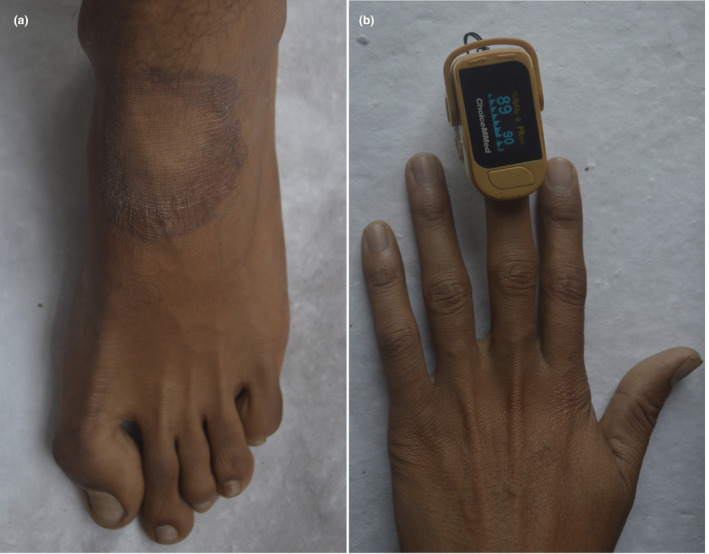Dear Editor,
A 24‐year‐old man, native of Bihar, India presented with a numb, ring like reddish patch over the left foot since 14 months (Fig. 1).
Figure 1.

(a) Annular plaque on left foot. (b) Pulse oximeter showing abnormal reading.
Dermatological examination revealed a solitary, well‐defined, hypotrichic, hypohidrotic, annular plaque, 7 cm in diameter over the dorsum of the left foot which was hypoaesthetic to pain, touch and temperature. No satellite lesions or nerve to patch was present. Left posterior tibial nerve and superficial peroneal nerve were thickened and non‐tender.
Patient was diagnosed as a case of Hansen's Disease (Borderline Tuberculoid) and was started on Multidrug Therapy (MDT) consisting of Rifampicin, Dapsone and Clofazimine since 07 February 2021. He presented for review on 20 February 2021 when he was incidentally detected to have oxygen saturation 88–90% on room air and was admitted as coronavirus disease 2019 (COVID‐19) suspect. Patient had no respiratory symptoms, history of contact with COVID‐19 patient or recent travel. Nasopharyngeal swab RTPCR for COVID‐19 was negative, and chest X‐ray revealed no abnormality. Arterial blood gas measurement was within normal limits and complete haemogram, biochemistry, urinalysis and ECG were normal.
Patient was reassessed and found to have a mild cyanotic hue over his fingers (Fig. 2). With suspicion of methaemoglobinaemia, blood was drawn for visual inspection, which revealed a chocolate brown colour. Methaemoglobin estimation in blood was done by spectrophotometry which revealed it to be 33.3% (Biological reference intervals: 0–2.0%). Based on temporal history of Dapsone intake, patient was suspected to have dapsone‐induced methaemoglobinaemia. Dapsone was omitted from the MDT regimen. Patient was closely monitored for progression of symptoms, and oxygen saturation was monitored with pulse oximetry. Within 72 h, cyanosis resolved and oxygen saturation levels returned to normal.
Figure 2.

(a) Cyanotic hue visible over fingers. (b) Chocolate‐coloured venous blood and the same when blotted on filter paper.
Pulse oximetry has become an important part of clinical assessment of patients in the COVID‐19 pandemic, and its use has greatly expanded. A pulse oximeter emits light of two different wavelengths, 650 and 805 nm and estimates the proportion of light absorbed and thus the proportion of oxyhaemoglobin; however, it cannot detect other forms of haemoglobin such as methaemoglobin. When other forms of haemoglobin are present in blood, a difference between the oxygen saturation estimated by pulse oximetry and arterial partial pressure of oxygen by blood gas analysis, or so‐called ‘saturation gap’ is seen. This has increased the detection of methaemoglobinaemia, which is otherwise a rare disease. 1
Methaemoglobin is a form of haemoglobin where iron is present in the ferric state instead of the ferrous state, thus making it incapable of binding and transporting oxygen. The causes of methaemoglobinaemia can be hereditary or acquired, which includes drugs and toxins like Dapsone which are strong oxidizing agents. When levels of methaemoglobin exceed 1–2% of the total haemoglobin, methaemoglobinaemia is said to be present. Levels of <25% are generally asymptomatic. Clinical manifestations can range from cyanosis, fatigue, headache to seizures, arrhythmias, coma and even death. Important clues to diagnosis are hypoxia which is refractory to oxygen supplementation and presence of chocolate‐coloured blood. 2 , 3
Treatment ranges from simply stopping the offending drug in asymptomatic cases to methylene blue for symptomatic cases. Other options include high‐dose ascorbic acid, exchange transfusion and hyperbaric oxygen therapy. 4 COVID‐19 is also known to produce a similar condition known as ‘happy hypoxia’ in which patients have low oxygen saturation but are not manifesting clinical features of respiratory distress. 5 Arterial blood gas analysis helps in quickly differentiating between methaemoglobinaemia and ‘happy hypoxia’. We should be watchful for both these conditions among dermatologic patients in the COVID‐19 pandemic.
Conflict of interest
None of the authors report any conflicts of interest.
Funding source
No funding sources supported this work.
Acknowledgements
The patient in this manuscript has given written informed consent to publication of his case details
Data availability statement
No data sets were generated or analysed during the course of this study.
References
- 1. Naymagon L, Berwick S, Kessler A, Lancman G, Gidwani U, Troy K. The emergence of methemoglobinemia amidst the COVID‐19 pandemic. Am J Hematol 2020; 95: E196–E197. [DOI] [PMC free article] [PubMed] [Google Scholar]
- 2. David SR, Sawal NS, Bin Hamzah MNS, Rajabalaya R. The blood blues: a review on methemoglobinemia. J Pharmacol Pharmacother 2018; 9: 1–5. [Google Scholar]
- 3. Pathania V, Shankar P, Sinha P, Tripathy D. A curious case of palpitation in a leprosy patient with low grade methemoglobinemia. Indian J Drugs Dermatol 2018; 4: 79. [Google Scholar]
- 4. Sahu KK, Mishra AK. Role of ascorbic acid in dapsone induced methemoglobinemia. Clin Exp Emerg Med 2019; 6: 91–92. [DOI] [PMC free article] [PubMed] [Google Scholar]
- 5. Dhont S, Derom E, Van Braeckel E, Depuydt P, Lambrecht BN. The pathophysiology of ‘happy’ hypoxemia in COVID‐19. Respir Res 2020; 21: 198. [DOI] [PMC free article] [PubMed] [Google Scholar]
Associated Data
This section collects any data citations, data availability statements, or supplementary materials included in this article.
Data Availability Statement
No data sets were generated or analysed during the course of this study.


